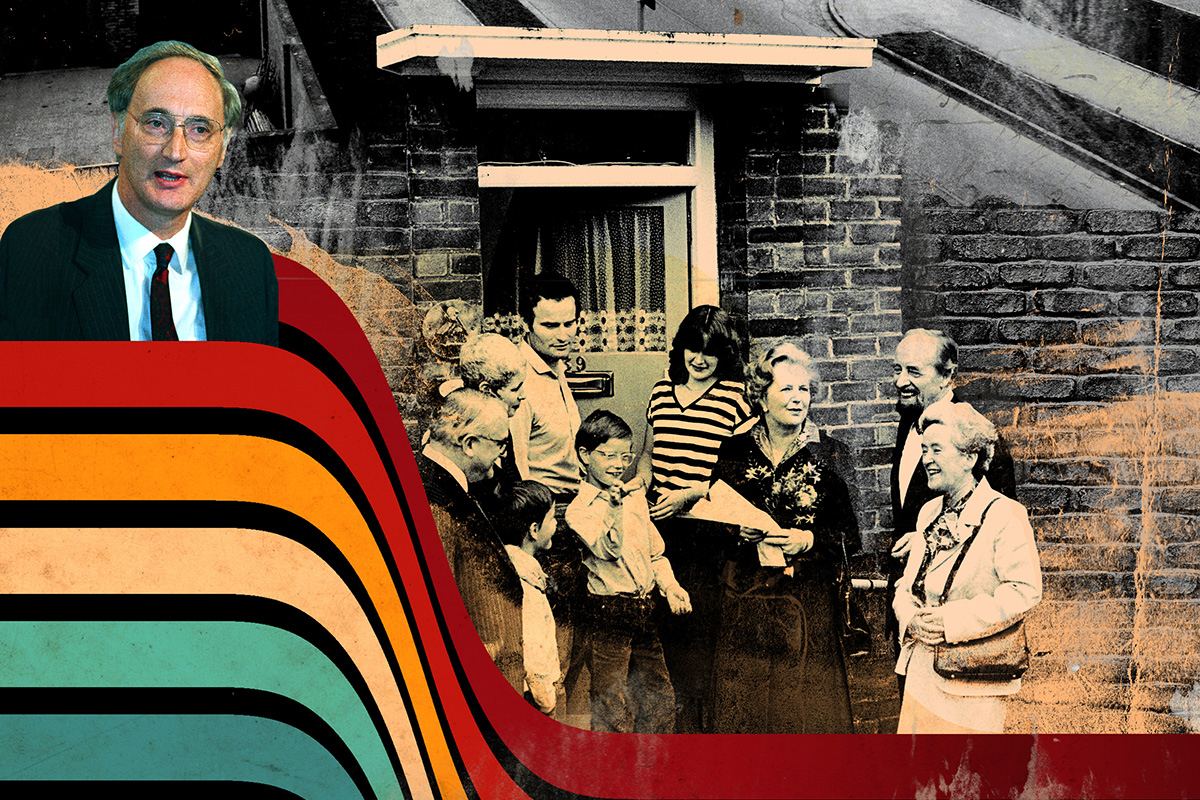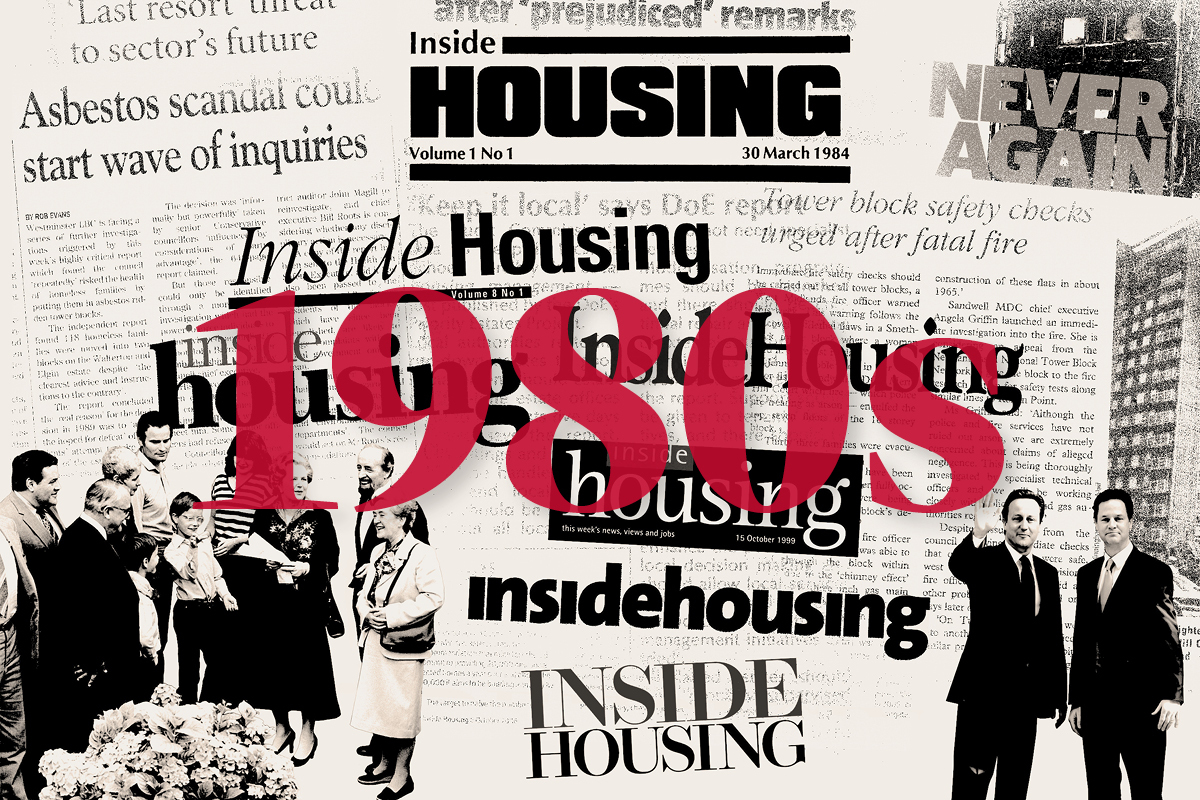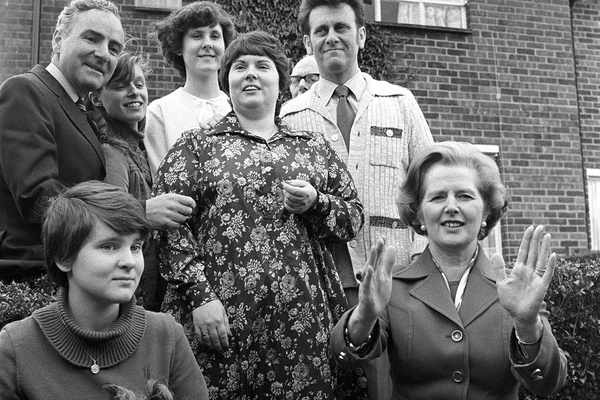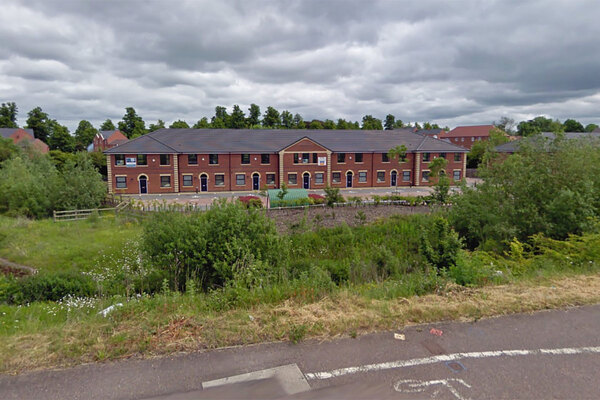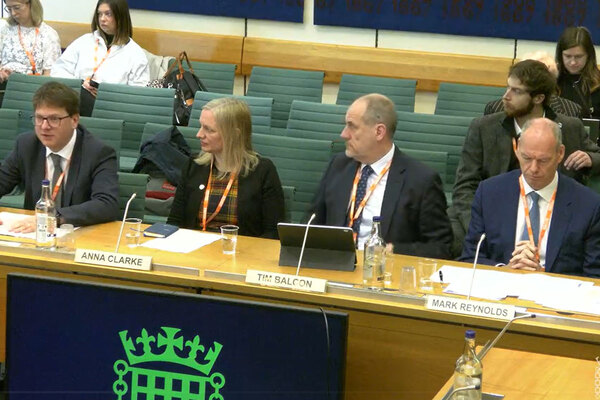The housing act from 1988 that shaped the sector today
Margaret Thatcher’s government spearheaded major reforms of the housing sector with the Housing Act 1988. Stephen Delahunty digs into the archives, and speaks to two of the key players at the time. Illustration by Michelle Thompson
It was the late 1980s and prime minister Margaret Thatcher, fresh off her third general election victory, had arrived for a housing policy discussion over dinner at Number 10.
Already in the room were John Major, then chief secretary to the Treasury, and Michael Howard, then housing minister. Mr Major was recalling his own experience of growing up in a council house when Ms Thatcher interrupted. “Oh, we lived in far worse conditions. We lived over a shop,” she said.
Peter Stredder laughs fondly as he recalls the anecdote. He is speaking to Inside Housing about his time as a policy advisor on housing to Mrs Thatcher between 1986 and 1988.
We meet because Mr Stredder played a key role in the introduction of the Housing Act 1988 – one of the most significant pieces of legislation in housing history. The act led to large-scale stock transfers from local authorities to housing associations, in a move Mr Stredder describes as the “Big Bang”.
Mega-mergers, 100,000-home housing associations, stock transfers, new rent products, the instability of private rent – all of these have their roots in the 1988 legislation. However, government files show this was not really the intention of the act.
To mark the magazine’s 40th anniversary year, Inside Housing has been digging into previously classified documents in The National Archives and speaking to people who worked with the government at the time, to look at what really drove the self-proclaimed Iron Lady’s reforms of the sector.
Strands of the act
The Housing Act 1988 broadly had three strands that, when combined, helped to create the modern-day housing market and gave rise to the housing association sector we see today.
The first was the introduction of private finance – or ‘mixed funding’ – for housing associations.
Second, the act made it easier to transfer stock from local authorities to housing associations.
Third was the private rented sector (PRS). Before the act, the PRS was regulated, rents were capped and tenants commonly had lifetime tenancies. This legislation swept these regulations away, laying the ground for the PRS we have today.
For Sir David Norgrove, who was private secretary to Mrs Thatcher between 1985 and 1988, the motivation for much of these changes were clear.
Now a member of the House of Lords, Sir David recalls of Mrs Thatcher: “She had a kind of visceral dislike of council estates. She also had a visceral dislike of local authorities.”
Although the policies introduced in 1988 led to the expansion of housing associations, this was not what politicians and advisors had envisaged. Declassified documents that crossed Mrs Thatcher’s desk during the creation of the act show advisors had hoped the act would give “tenants a new start, writing off the mistakes of the past, giving them a stake and much greater say in the future and reducing substantially their dependency on the state”.
This was documented in part in one ‘tightly restricted’ paper, which included Mr Stredder’s views, that landed on Mrs Thatcher’s desk in January 1987. One of the ideas under discussion was how to break the dependence of council tenants on the state.
The act introduced the Tenants’ Choice policy, which gave tenants on housing estates the ability to change their social landlord. Tenants used this power successfully, albeit controversially, in Westminster, where the council intended to sell the Walterton and Elgin estates to private developers. Instead, tenants voted to take control of the estates and the homes were transferred to newly created housing association Walterton and Elgin Community Homes.
At the time of the legislation, the government was concerned “that left-wing activists will take over trusts” and so safeguarding would be needed to address this. Mr Stredder wrote at the time: “They are not intended as the long-term way of running the stock, since this would replace one monopoly landlord with another.”
While tenants may have been the preferred choice for estate management, the documents show that housing associations were at the front of plans to take over the homes following the act, as they were praised for their professional management, concern for welfare of tenants, and efficient and professional management.
Mr Stredder, now a member of the finance committee at housing association Poplar HARCA, tells Inside Housing that they did not envision landlords as large as those seen today. At the time, a large association was one with around 5,000 homes.
Mr Stredder says: “All they [tenants] really wanted was to have homes that were inexpensive and well looked after and maintained; getting involved in the running of that wasn’t really something that interested many.”
The short-lived Tenants’ Choice policy was scrapped in 1996, after only around six successful transfers.
With the Housing Act passing through parliament, policy discussions turned to how removing rent control for private rented homes would impact tenants, and the benefit bill as rents increased. In January 1991, then-housing minister Sir George Young uttered the infamous phrase “housing benefit will take the strain” in a short debate initiated by a backbench MP by the name of Jeremy Corbyn.
Mr Corbyn’s concern was the increase in rents during 1990-91, which he feared were outstripping increases in earnings. The response from the housing minister was not to review the impact of the first few years of uncontrolled market rents.
Right to Buy
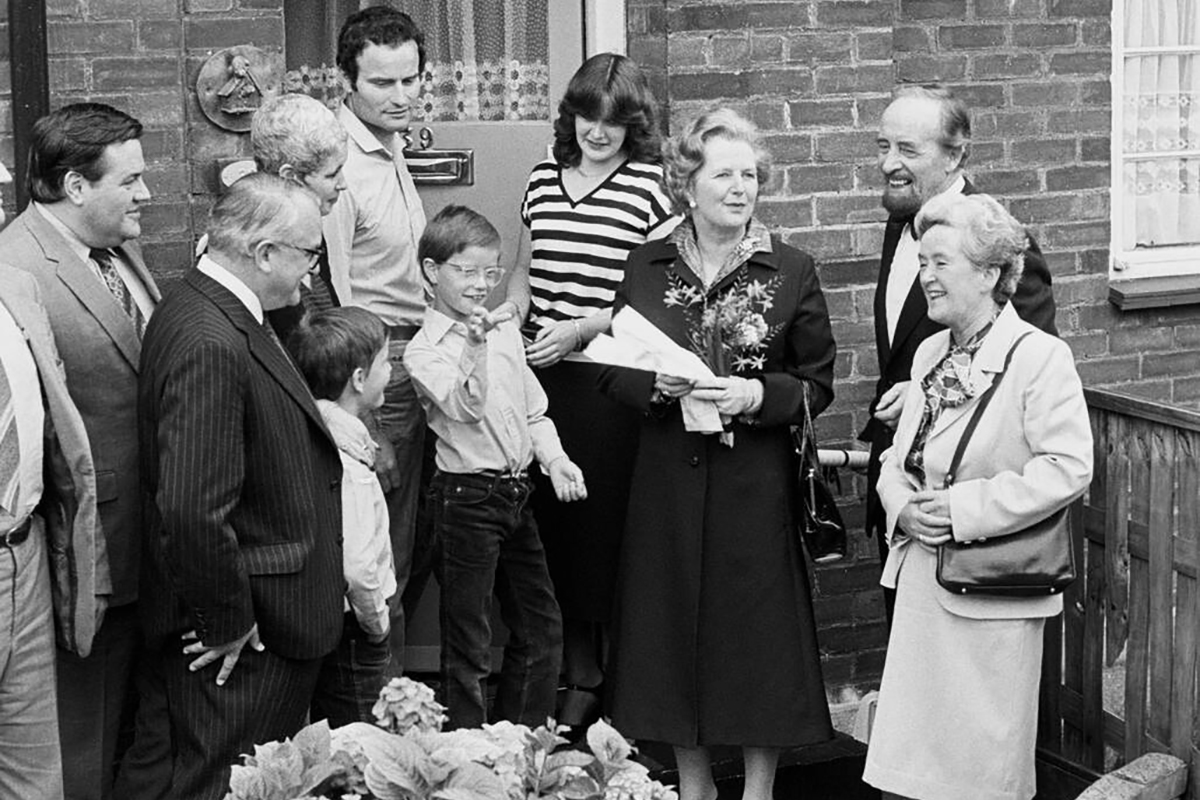
“In terms of policy, [Margaret Thatcher’s] big idea was really Right to Buy. The other big idea, I suppose, was she didn’t want to spend too much taxpayers’ money,” says Sir David Norgrove. “Now people look back and say, ‘Oh, well, councils have obviously not built homes enough since then in the meantime.’ But I would say, and I think it still is, that the policy was always one of aspiration in the short term.”
The initial policy idea for the Right to Buy offered tenants who had lived in their home for three years a 33% discount on the market value of the property. The declassified files from between 1986 and 1988 show that it was hoped that Right to Buy sales would reduce the number of tenants to 5.5 million by 2001. At the time there were 6.5 million tenants in England. A quarter received some help with their rent through housing benefit and 33% had the full cost of their rent covered, which cost the government £2.3bn. The figure for today is more than 10 times that amount, at around £30bn.
Successive governments have increased the discount over the years and fiddled with the policy in such a way that its impact on the housing crisis has been substantial. There are few voices in the sector that wish to keep the policy. The current Labour government is considering preventing tenants from buying newly built social homes for a given period and has a target to replace all future social homes sold on a one-for-one basis.
Peter Stredder says: “[Mrs Thatcher] was mainly concerned with trying to increase homeownership. She didn’t have a great deal of interest in council housing, but obviously at that time, quite a lot of public expenditure went on council housing.”
Sir George said: “I do not accept the premise on which the [honourable] gentleman based his question. Housing benefit will underpin market rents – we have made that absolutely clear. If people cannot afford to pay that market rent, housing benefit will take the strain.”
At the start of the 1990s, Mrs Thatcher asked Sir George to complete an analysis on the impact of the 1988 act on the housing benefit system and homelessness. The declassified files in the few years running up to this short debate in 1991 show expenditure on housing benefit was expected to rise from £2.4bn to £8bn by the end of the parliamentary term in 1991. The government predicted the percentage of tenants receiving the benefit to jump from 60% to 90%.
But the government also expected the cost would be offset by the extra rental income, Right to Buy sales and preventing councils from building new homes.
During a trawl through the archives, Inside Housing came across a document sent to Mrs Thatcher at the start of 1988, which concluded that the impact of higher rents would significantly affect the standard of living of pensioners and families with children. Despite this effect, the government decided that local authorities would meet part of the cost of housing benefit and put the “true cost of council housing” on a “more business-like footing”.
‘Council estate culture’
In March 1988, Sir David Norgove had prepared a briefing note for the prime minister on how “politically and socially acceptable a large rise in rents was likely to be”. It was hoped the higher rent increases would incentivise residents into work. This was at a time when 55% of all unemployed people – and 73% of the long-term unemployed – lived in council estates.
The documents show the government blamed this on a “lack of motivation and initiative reinforced by the council estate culture”, where “taking responsibility for your family and future is not the norm”, and “instead one learns to gain by ‘working the system’”. Mrs Thatcher was advised to launch a “direct attack” on this culture of dependency.
However, a letter sent in March 1988 in response to this policy discussion was concerned that the proposal would almost treble housing benefit and that private landlords would raise rents above market rates and “simply collect the money from the government”.
Future prime minister Mr Major was one of the people who raised concerns that increasing rents may not incentivise tenants into work as hoped. In a document at the time, he warned of “the political consequences of imposing limits on benefit before we have a clear picture of how the deregulated rented housing market is operating in different parts of the country”.
Back to 2024, with many local authorities sounding the alarm that their spending on housing benefits and temporary accommodation was at risk of making them bankrupt over the next 12 months, does Mr Stredder have any regrets about some of the policies the Housing Act 1988 introduced?
He says there were many “unintended consequences”. But he argues that comparing the 1980s to now is difficult, as the political and economic thought at the time was one that rent control in the private sector was “an economically inefficient way of providing housing for the poorest in society”.
Sir David Norgrove can recall less of the policy discussions, but he speaks fondly of his time working with Mrs Thatcher. He left his role working for the prime minister at around the time of the act’s passage in 1988. By 1999, he was chair of the board at Marks and Spencer.
He says: “What you see is what you get. She wasn’t that different from the way that she was in public. She was courteous and rarely lost her temper with her civil servants and staff.
“She would listen, she wanted to debate and wanted to discuss things. Of course, she came from a very, very defined set of beliefs that you couldn’t persuade her of something that went against those.”
Recent longform articles by Stephen Delahunty
How recent changes to debt rules could affect the housing sector
The first Labour Budget in 14 years suggested that the chancellor has been listening to the social housing sector. Stephen Delahunty sums up the funding announcements that will have the biggest impact for housing providers
How will exemption from the local connection test work?
The government announced it would exempt certain groups from the local connection test when they apply for social housing. Stephen Delahunty finds out what sector figures think is needed for it to work
Sign up for our regulation and legal newsletter
Already have an account? Click here to manage your newsletters
